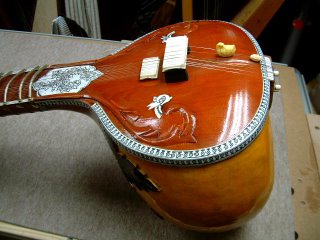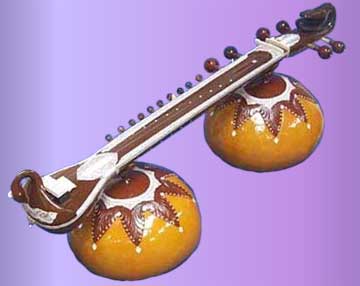
Raga Review
Bhimpalasri - A Delightful Afternoon Raga
A.H. Jaffor Ullah
Of all the day-ragas, Bhimpalasri is my most favorite one, unquestionably. If you listen to the raga intently, you will realize what I am talking about. Once you begin to like it, the raga will grow in your mind like a contagion and there will be no escape or immunity from it.
In the book 'Sangita-Raga-Kalpadruma,' Bhimpalasri is described as a maiden “With wide eyes and fragrant with celestial flowers," the same article goes to describe the raga as follows: "Bhimapalasri, the sages tell, sings with her deep voice to the lute. Her lovely form is the embodiment of art.”
A western musician by the name Michael Robinson, who specializes on eastern music, described the mid-afternoon raga as follows: "I find this monumental mid-afternoon raga to reach deeply into our hopes, dreams and memories with a vision of mystical adventure, blissful union and ecstasy."
This raga belongs to thaat Kafi, which contains many beautiful ragas played mostly at afternoon and early evening. The raga Patdeep is a case in point that sounds very much like Bhimpalasri with minor variations, of course. Bhimpalasri uses komal gandhar (Ga), komal nishad (Ni), all other notes are shuddha.
In the book 'Sangita-Raga-Kalpadruma,' Bhimpalasri is described as a maiden “With wide eyes and fragrant with celestial flowers," the same article goes to describe the raga as follows: "Bhimapalasri, the sages tell, sings with her deep voice to the lute. Her lovely form is the embodiment of art.”
A western musician by the name Michael Robinson, who specializes on eastern music, described the mid-afternoon raga as follows: "I find this monumental mid-afternoon raga to reach deeply into our hopes, dreams and memories with a vision of mystical adventure, blissful union and ecstasy."
This raga belongs to thaat Kafi, which contains many beautiful ragas played mostly at afternoon and early evening. The raga Patdeep is a case in point that sounds very much like Bhimpalasri with minor variations, of course. Bhimpalasri uses komal gandhar (Ga), komal nishad (Ni), all other notes are shuddha.
For those of you who follow musical notations (our sub-continental one), the ascending or Aaroho is: n-S-g-m-P-n-S’. The descending or abaroho notes are: S’-n-D-P-m-g-R-S. The signature or Pakar of Bhimpalasri raga is: ’n-S-g-m-P-g, m-g-R-’n-S. If you happen to have a harmonium, then play the ascending, descending, and the signature tune of the raga and immediately you will realize what a beautiful raga Bhimpalasri is. Also you will realize that quite a few beautiful Nazrul Gitis are set in Bhimpalasri raga. For example, the song "mor ghumo ghorey ke ele monohor, nomo nomo" immortalized by Feroza Begum. Another Nazrul song sung by Gitasri Shandhya Mukherjee entitled "biday sandhya ashilo oi" was also set in this raga. Quite a few Atul Prasadi songs are set in this raga too. For example the song "dao dao go morey amar porano bhoria dao." I also remember from my childhood days in 1950s one particular Shyama Sangeet that became very popular allover Bangladesh. The lyric is as follows:"ma amar sadh na mitilo ash na purilo shokoli furaye jai ma." This masterpiece sung probably by Dhananjoy Bhattacharyya was also set in Bhimpalasri raga.
Many Bombay film songs in Urdu/Hindi were set in Bhimpalasri in the days when songs in the celluloid were simpler and melodious. One particular haunting song sung by Lata Mangeshkar in film "Mere Saya" (My Shadow) went like this: "nainon mein badara chhaye, bijali si chamke haaye." Undoubtedly, this is still considered by many as one of the best song that Lataji did for Bombay film. The music director was Madan Mahon who mostly composed film song based on ragas.
Another song from yesteryears that I have in my collection is a song sung by Suraiyya (the legendary film actress of 1940s and 1950s) in the film Mirza Ghalib. The first line of the song is; "ye na thi hamari kismat ki visaal-e-yaar hota." Those of you who belong to my generation and were interested in semi-classical music may remember some of the songs that I mentioned in this article. I trust many will  agree with me on this that songs tuned after Bhimpalasri could stand apart from other songs. The raga is very effective in expressing one's thought whether it is the yearning of a person to meet his or her beloved or expressing a vision for blissful reunion. There is also a devotional side of the raga that is so obvious when one listens to Shyama Sangeet.
agree with me on this that songs tuned after Bhimpalasri could stand apart from other songs. The raga is very effective in expressing one's thought whether it is the yearning of a person to meet his or her beloved or expressing a vision for blissful reunion. There is also a devotional side of the raga that is so obvious when one listens to Shyama Sangeet.
Not long ago, Pundit Ajay Chakrabarty of Kolkata had published a CD that contains 12 raga-based modern songs of which one is based on Bhimpalasri. I am including this song in my write-up. Please click on the following link to play the song. After listening to it several times you will agree that Bhimpalasri as a raga is class by itself. This raga is also called Bhimpalasi in Hindi belt of North India. It hardly matters what you call it, this raga is a gem.
 agree with me on this that songs tuned after Bhimpalasri could stand apart from other songs. The raga is very effective in expressing one's thought whether it is the yearning of a person to meet his or her beloved or expressing a vision for blissful reunion. There is also a devotional side of the raga that is so obvious when one listens to Shyama Sangeet.
agree with me on this that songs tuned after Bhimpalasri could stand apart from other songs. The raga is very effective in expressing one's thought whether it is the yearning of a person to meet his or her beloved or expressing a vision for blissful reunion. There is also a devotional side of the raga that is so obvious when one listens to Shyama Sangeet.Not long ago, Pundit Ajay Chakrabarty of Kolkata had published a CD that contains 12 raga-based modern songs of which one is based on Bhimpalasri. I am including this song in my write-up. Please click on the following link to play the song. After listening to it several times you will agree that Bhimpalasri as a raga is class by itself. This raga is also called Bhimpalasi in Hindi belt of North India. It hardly matters what you call it, this raga is a gem.
For serious music lover, may I humbly request you to please listen to a sitar or sarod recital set in Bhimpalasri? You will then agree with me that this is one of the best ragas to come out of our subcontinent. I feel pity for those who had all but ignore our sub-continent's classical music all through their life. I don't know about you but my life would be incomplete without the raga music of our motherland. If you say you do not understand the raga music, I would say try to listen to some simple melodies. Start with lighter form of classical music such as ghazal, thumri, etc., and only then go full blast for kheyal. The beauty of classical music is awesome. Ask someone who loves our raga music. Please click on the following link to listen to Pundit Ajay Chakrabarty’s melodious voice who sings with passion the song "ami nutone'r avilashee."
Please audition "ami nutone'r avilashee" (a song from his CD "feraye diona morey"
Please audition "ami nutone'r avilashee" (a song from his CD "feraye diona morey"
---------------------
Dr. A.H. Jaffor Ullah, a researcher, columnist, and a blogger, is from Ithaca, New York
Dr. A.H. Jaffor Ullah, a researcher, columnist, and a blogger, is from Ithaca, New York
Comments could be directed at - jaffor@yahoo.com



3 Comments:
Pardon my relative lack of knowledge about Indian music tradition, but can you tell me if Rag Bhimpalasri is different from Rag Bhimpalasi? I have a recording of Bhimpalasri by Nikhil Banerjee, and it is one of my most treasured recordings I have ever heard. When I looked it up in the book "The Raga Guide," only Bhimpalasi (no "r") was listed, and it seemed to have a different quality to it. Are these two separate ragas, or simply minor (regional?) differences in spelling?
Thanks for your help.
By Chris, At
8:09 AM
Chris, At
8:09 AM
Chris: Rag Bhimpalasri and Rag Bhimpalasi is essentially the same Rag. In Bengal, the Rag is known as Bhimpalasri, whereas, in Uttar Pradesh and in the Hindi belt the same Rag is known as Bhimpalasi. In a concert in the sixties Ravi Shankar while playing this Rag introduced his piece as Rag Bhimpalasi even though he is a Bengali (originated from Jessore district, which is now in Bangladesh).
By Jaffor, At
7:27 PM
Jaffor, At
7:27 PM
but i think nazrul giti mor ghumo ghore ele monohor < this song is based on raga bhairabi . wht u think sir ?
By Unknown, At
5:13 PM
Unknown, At
5:13 PM
Post a Comment
Subscribe to Post Comments [Atom]
<< Home